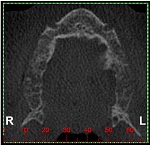Trifid nasopalatine canal: case report of a rare anatomical variation and its surgical implications
Keywords:
Nasopalatine canal, anatomical variation, computed tomography, dental implant.Abstract
Introduction: the nasopalatine canal is a long slender structure present in the midline of the anterior maxilla that connects the palate to the floor of the nasal cavity. The nasopalatine canal contains the nasopalatine nerve, the terminal branch of the nasopalatine artery, fibrous connective tissue, adipose tissue, and minor salivary glands.
Objective: the purpose of this article was to report a case of a trifid nasopalatine canal detected by cone beam computed tomography prior to dental implant placement.
Case report: a 47-year-old female patient was submitted to cone beam computed tomography. Axial and sagittal sections revealed a trifurcation of the nasopalatine canal. Each canal was separated from the other by bony septa and extended independently from the floor of the nasal cavity to the incisive foramen in the remnant of the alveolar process in the anterior region of the maxilla. Cone beam computed tomography has permitted better visualization of the details and anatomical variations of the nasopalatine canal.
Conclusion: detailed knowledge of variations in the shape, number and size of the nasopalatine canal is fundamental for surgical procedures, such as local anesthesia in the anterior maxillary region and placement of dental implants, in order to prevent damage to important arteries and nerves.
Downloads

Published
How to Cite
Issue
Section
License
Authors retain all rights to their works, which they can reproduce and distribute as long as they cite the primary source of publication.
The Rev Cubana Estomatol is subject to the Creative Commons Attribution-Non-Commercial 4.0 International License (CC BY-NC 4.0) and follows the publication model of SciELO Publishing Schema (SciELO PS) for publication in XML format.
You are free to:
- Share — copy and redistribute the material in any medium or format.
- Adapt — remix, transform, and build upon the material.
The licensor cannot revoke these freedoms as long as you follow the license terms.
Under the following terms:
Attribution — You must give appropriate credit, provide a link to the license, and indicate if changes were made. You may do so in any reasonable manner, but not in any way that suggests the licensor endorses you or your use.
- NonCommercial — You may not use the material for commercial purposes.
No additional restrictions — You may not apply legal terms or technological measures that legally restrict others from doing anything the license permits.
Notices:
- You do not have to comply with the license for elements of the material in the public domain or where your use is permitted by an applicable exception or limitation.
- No warranties are given. The license may not give you all of the permissions necessary for your intended use. For example, other rights such as publicity, privacy, or moral rights may limit how you use the material.

